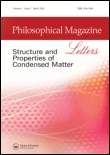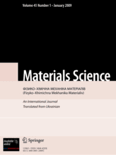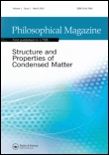
PHILOSOPHICAL MAGAZINE LETTERS
Scope & Guideline
Bridging Theory and Experiment in Condensed Matter
Introduction
Aims and Scopes
- Materials Characterization and Modelling:
Research focuses on the detailed characterization of various materials, including metals, alloys, and composites, using advanced techniques such as X-ray imaging, electron microscopy, and computational modelling. - Mechanical Behaviour and Properties of Materials:
The journal covers studies on the mechanical properties of materials, including toughness, ductility, and strength, particularly in relation to microstructural changes and processing conditions. - Advanced Processing Techniques:
Papers often explore novel processing methods, such as laser cladding, additive manufacturing, and heat treatments, to enhance the performance of materials. - High-Entropy Alloys and Complex Materials:
There is a significant focus on high-entropy alloys and other complex materials, examining their unique properties and potential applications in various fields. - Machine Learning and Data-Driven Approaches:
The journal is increasingly incorporating machine learning and data-driven methodologies to predict material properties and optimize processing parameters.
Trending and Emerging
- Machine Learning in Materials Science:
There is a growing trend towards the application of machine learning techniques to analyze and predict material behaviors, enhancing the efficiency of research and development processes. - Sustainable and Green Materials:
Increasing interest in environmentally friendly and sustainable materials is evident, with research focusing on bio-based composites and the recycling of materials becoming more prominent. - Nanostructured and Advanced Materials:
Research on nanostructured materials and their unique properties is on the rise, highlighting their potential applications in various high-tech fields. - Interdisciplinary Approaches:
The journal is witnessing a trend towards interdisciplinary research, combining insights from physics, chemistry, and engineering to solve complex materials challenges. - Electrochemical and Energy Materials:
There is a notable increase in studies related to electrochemical materials, particularly for energy storage and conversion applications, reflecting the global push for renewable energy solutions.
Declining or Waning
- Traditional Metallurgy Techniques:
There has been a noticeable decline in publications focused solely on traditional metallurgy techniques, as newer approaches and advanced materials become more prominent. - Low-Temperature Processing Studies:
Research related to low-temperature processing and its effects on material properties appears to have decreased, possibly due to a shift towards high-temperature or advanced processing techniques. - Basic Theoretical Studies:
The journal has seen fewer submissions of purely theoretical studies without experimental validation, as the trend shifts towards more applied research with practical implications.
Similar Journals

Computational Condensed Matter
Empowering Researchers with High-Quality, Peer-Reviewed InsightsComputational Condensed Matter, a reputable journal published by Elsevier, serves as a critical platform for advancing the understanding of condensed matter physics and related fields. Since its inception in 2014, the journal has become a pivotal resource for researchers and professionals dedicated to exploring electronic, optical, and magnetic materials, as well as materials chemistry and general materials science. With its current standing in the Q3 quartile across multiple categories in 2023, it ranks within the 60th percentile for Materials Science (miscellaneous) and the 54th percentile for Condensed Matter Physics in Scopus, reflecting its growing influence and relevance in the scientific community. The journal aims to publish high-quality, peer-reviewed articles that can foster innovation and collaboration in computational methods applied to condensed matter systems. Researchers interested in cutting-edge insights and methodologies will find Computational Condensed Matter to be an invaluable addition to their academic resources. For those seeking to contribute to or stay informed about the latest advancements in the field, this journal is a must-read.

MATERIALS SCIENCE-POLAND
Exploring the Depths of Material InnovationMATERIALS SCIENCE-POLAND, published by SCIENDO, is an esteemed open access journal dedicated to the rapidly evolving field of materials science. Since its inception in 2002 and transitioning to an open access model in 2015, the journal has been a vital platform for researchers and professionals to disseminate their findings and contribute to the scientific community. With an ISSN of 2083-134X and an E-ISSN of 2083-134X, it spans a comprehensive range of disciplines, focusing on condensed matter physics, materials science, and mechanical engineering among others. In the 2023 rankings, it holds a position in the Q4 and Q3 quartiles across various categories, showcasing its relevance and ongoing contribution to these fields. Researchers benefit from its accessibility, enabling wider reach and engagement with contemporary topics in material innovation and applications. As the journal continues to evolve until 2024, it remains a cornerstone for scholars looking to advance their knowledge and research in materials science.

MATERIALS SCIENCE
Shaping the Future of Materials Engineering.MATERIALS SCIENCE, a prominent journal published by SPRINGER, serves as a vital resource for researchers, professionals, and students in the fields of materials science, mechanical engineering, and condensed matter physics. With its ISSN 1068-820X and E-ISSN 1573-885X, this journal has been dedicated to sharing innovative research since its inception in 1993, and it continues to publish groundbreaking findings through 2024. Although it operates as a traditional subscription-based journal, its ranking in the Q3 quartile across multiple scientific categories, including Condensed Matter Physics, Materials Science, Mechanical Engineering, and Mechanics of Materials, signifies its relevance and impact in the academic community. Notably, its Scopus classifications reveal a competitive standing among its peers, ranking within the 25th to 33rd percentiles across various engineering and physics disciplines. The journal remains a key platform for disseminating valuable insights, fostering collaboration, and advancing the understanding of materials science.

Crystals is a premier open-access journal, published by MDPI since 2011, that focuses on the multidisciplinary fields of chemical engineering, condensed matter physics, inorganic chemistry, and materials science. With its E-ISSN 2073-4352, the journal is headquartered in Switzerland, and actively contributes to the global scientific community by facilitating the dissemination of high-quality research. Ranking in the Q2 quartile across multiple categories, including Chemical Engineering (miscellaneous) and Materials Science (miscellaneous) for 2023, Crystals provides a platform for innovative studies that span from fundamental research to practical applications. The journal's commitment to open access ensures that groundbreaking findings are readily available to researchers, professionals, and students alike, fostering an environment of collaboration and knowledge sharing that is essential in advancing the scientific understanding of crystalline materials.

Materials Letters-X
Advancing the Frontiers of Materials ScienceMaterials Letters-X, published by ELSEVIER, is an esteemed open-access journal dedicated to the rapid communication of research in the fields of Condensed Matter Physics, Materials Science, Mechanical Engineering, and Mechanics of Materials. Launched in 2019, this journal has quickly established itself within the academic community, achieving Q3 quartile rankings in several categories according to the 2023 metrics. The journal's impactful contributions are reflected in its Scopus rankings, notably within Mechanical Engineering (Rank #308) and Mechanics of Materials (Rank #199). The open-access model promotes widespread dissemination and accessibility, ensuring that cutting-edge advancements in material science are readily available to researchers, professionals, and students worldwide. As it continues to grow, Materials Letters-X aims to inspire innovation and collaboration across disciplines, making it a pivotal resource for those engaged in material research and applications.

PHILOSOPHICAL MAGAZINE
Illuminating Complexities in Physical SciencesPHILOSOPHICAL MAGAZINE, published by Taylor & Francis Ltd, is a distinguished journal that focuses on the field of Condensed Matter Physics. With an ISSN of 1478-6435 and an E-ISSN of 1478-6443, this journal serves as a vital platform for researchers and professionals seeking to disseminate and access cutting-edge research and developments in the field. Currently ranked in the Q3 category within its discipline according to the 2023 quartiles, and positioned at the 45th percentile in Scopus rankings, PHILOSOPHICAL MAGAZINE is recognized for its significant contributions to theoretical and experimental physics. The journal embraces open access options, enhancing its reach and accessibility to a global audience. With coverage spanning from 2003 through 2024, it remains a cornerstone for scholars and students who aim to deepen their understanding of the complexities within condensed matter systems. For anyone engaged in the physical sciences, PHILOSOPHICAL MAGAZINE offers invaluable insights and fosters an environment of rigorous academic inquiry.

Physical Mesomechanics
Advancing the frontiers of materials science and mechanics.Physical Mesomechanics is a distinguished journal published by SPRINGER, focusing on the interdisciplinary field of condensed matter physics, materials science, and mechanics of materials. With an ISSN of 1029-9599 and an E-ISSN of 1990-5424, this journal serves as an essential platform for researchers, professionals, and students to share and disseminate high-quality research findings. It is recognized for its significant impact, boasting a Q2 ranking in 2023 across multiple categories including Condensed Matter Physics and Materials Science, ensuring a substantial scholarly contribution to the field. Despite being a subscription-based journal, its reputation within the academic community remains robust, underlined by its comprehensive coverage of topics related to the behavior of materials at the mesoscopic scale. The journal promises to further enhance its importance in the scientific dialogue by encouraging submissions that push the boundaries of current knowledge from 2004 to 2024, fostering innovation and collaboration among researchers globally.

PHYSICS OF METALS AND METALLOGRAPHY
Diving Deep into the World of Metals and AlloysPhysics of Metals and Metallography, published by MAIK Nauka/Interperiodica/Springer, is a respected journal dedicated to the study of the physical properties of metals and their metallographic analysis, offering invaluable insights for researchers, professionals, and students in the fields of condensed matter physics and materials chemistry. With an ISSN of 0031-918X and an E-ISSN of 1555-6190, the journal has a rich history that spans from 1970 to 2024, reflecting a long-standing commitment to advancing knowledge in this vital area of materials science. Although it currently does not offer Open Access options, its strong placement in the academic landscape is underscored by its Q3 ranking in both Condensed Matter Physics and Materials Chemistry, according to 2023 metrics, and a Scopus ranking that places it within the competitive percentile of its fields. The journal is particularly important for those engaged in the cutting-edge research and technological applications of metals and alloys, making it an essential resource for anyone looking to deepen their understanding or contribute original findings to this dynamic discipline.

TRANSACTIONS OF THE INDIAN INSTITUTE OF METALS
Showcasing groundbreaking research in metals and alloys.TRANSACTIONS OF THE INDIAN INSTITUTE OF METALS is a premier journal published by Springer India, dedicated to the field of metallurgy and materials science. Established in 1969, this journal serves as a vital platform for researchers and professionals to disseminate their findings on metals and alloys, showcasing innovative studies and experimental techniques. With an impressive impact factor and categorized in the Q2 quartile for metals and alloys as of 2023, it ranks 70 out of 176 in its field according to Scopus, placing it in the 60th percentile. The journal maintains a robust reputation for fostering academic excellence, thus attracting contributions from both established and emerging scholars. Though not an open access publication, its well-curated content remains a crucial resource for advancing knowledge and technology in metallurgy. The journal's extensive operational history, particularly during notable converged years, underscores its enduring significance in the scientific community.

ACTA METALLURGICA SINICA
Catalyzing Scholarly Dialogue in MetallurgyACTA METALLURGICA SINICA, established in 1978 and published by SCIENCE PRESS, stands as a preeminent journal in the fields of metallurgy and materials science. This journal is particularly revered for its contributions to Metals and Alloys, Mechanical Engineering, Geotechnical Engineering, and Mechanics of Materials, with a commendable Q1 ranking in Metals and Alloys and notable placements in other engineering disciplines. With a robust history of facilitating scholarly communication from 1978 to 1991 and consistently since 1996, the journal provides a vital platform for researchers and practitioners to disseminate significant advancements in material science. Despite being a subscription-based journal, ACTA METALLURGICA SINICA remains pivotal, holding a Scopus ranking that places it in the top tiers of its categories, fostering an environment ripe for innovation and collaboration. This ensures that the journal remains central to the ongoing discussions and developments within the metallurgy community, serving both academic and professional interests.